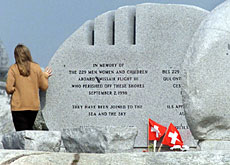Electrical fire downed Swissair flight 111

The fire that brought down Swissair jet off the coast of Nova Scotia in 1998 was likely caused by an electrical fault in the plane's entertainment system.
That’s the conclusion of Canadian investigators, who released the results of a four-and-a-half year probe into the incident on Thursday.
The investigation, which cost over $50 million (SFr68 million), has generated 23 safety recommendations.
Switzerland praised the work of the investigators into the crash, which claimed the lives of many Swiss nationals.
André Schrade of the Federal Office for Civil Aviation told swissinfo that Switzerland was highly satisfied with the report’s conclusions.
The Canadian safety board is not a regulator and does not assign fault or determine criminal or civil liability.
All 229 people aboard the McDonell Douglas MD-11 were killed when the Swissair flight, bound for Geneva from New York, crashed into the Atlantic Ocean on September 2, 1998.
In the flight’s final moments, the pilots reported smoke in the cockpit and dumped fuel in the ocean before trying to reach Halifax for an emergency landing.
“At a point along the flight route… a failure event occurred that provided an ignition source to flammable materials in the aircraft,” the Transportation Safety Board of Canada said, noting that damage had been found to wiring on the plane.
“This set off an in-flight fire that spread and increased in intensity until it led to the loss of the aircraft and human life.”
The type of inflight entertainment system used on board the MD-11 was installed only in Swissair planes and in a limited number of aircraft belonging to the Italian national carrier, Alitalia.
New safety measures
The Transportation Safety Board of Canada added nine new air safety recommendations to those in an interim report, urging regulators to develop tests and standards for flammability for all insulation materials on commercial jets.
It also called for measures to improve the quality of cockpit voice recorders, ensuring that separate generators powered separate flight recorders so that at least one record would be left if one power system failed.
The board had earlier recommended that airlines provide in-flight firefighting measures and improve power supplies. It said pilots should try to land as soon as there was a sign of smoke or fire, rather than trying to dump fuel.
The board also said all aircraft systems, including oxygen, hydraulics and air conditioning, should be evaluated to see how they might contribute to a fire, or what would happen if the system failed when a fire was already in progress.
It said aircraft certification standards for material flammability at the time of the accident were “inadequate”.
No fire detection
The plane had no smoke or fire detection devices, nor suppression equipment in the area where the fire started – although there were no regulations at the time that called for this equipment – and by the time the flight crew realized the plane was in trouble, the fire had become uncontrollable.
But the report said there was nothing the pilots could have done to prevent this crash because a number of the aircraft systems failed simultaneously.
Even if the pilots had “foreseen the eventual deterioration due to the fire – because of the rapid progression of the fire, they would not have been able to complete a safe landing in Halifax,” it said.
Chief investigator Vic Gerden told swissinfo: “We believe the flammable material was a big outcome of this accident and it would not have happened without such material in the aircraft.”
Detailed reconstruction
The investigation into the crash was one of the biggest in aviation history.
Over two million fragments of wreckage were salvaged from the ocean floor, some 50 to 60 metres below the surface of where the aircraft crashed into the picturesque bay of St Margaret, ten kilometres from Peggy’s Cove in Halifax.
From the outset, investigators focused their attention on the front section of the aircraft, around the cockpit partition, where fire and heat traces were identified.
Burn marks were found on some 1,000 cables and another 5,000 fragments of wreckage.
The aircraft’s flight and cockpit voice recorders provided few clues to the disaster, having switched off about six minutes before the crash.
Investigators were left with little choice but to painstakingly reconstruct an 11-metre long segment of the MD-11’s front end.
Using state-of-the-art techniques, they pieced together what were often only coin-sized fragments in an effort to shed light on possible causes.
Counselling
Although Swissair is now defunct, its Family Assistance Center continues to offer counselling to victims’ families.
However, the Swiss firm, CareLink, based in Kloten, is set to take over at the end of March and will provide assistance to the bereaved until the end of this year.
swissinfo with agencies
Swissair Flight SR-111 crashed off the Canadian coast in September 1998, killing all 229 people on board.
Fragments of wreckage recovered from the scene pointed to a fire as the cause of the disaster.
Canadian investigators concluded that an electrical spark from the inflight entertainment system caused the fire.

In compliance with the JTI standards
More: SWI swissinfo.ch certified by the Journalism Trust Initiative










You can find an overview of ongoing debates with our journalists here . Please join us!
If you want to start a conversation about a topic raised in this article or want to report factual errors, email us at english@swissinfo.ch.